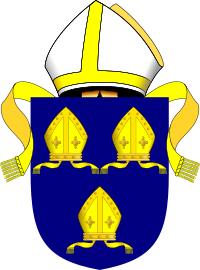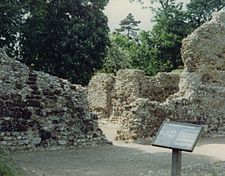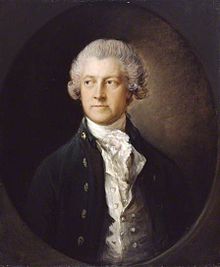Bishop of Norwich
After the Conquest the seat was moved in 1070 to Thetford, before finally being located in Norwich in 1094 under William II, ahead of the completion of the new cathedral building.Though the see took the name Norwich in the 11th century, its history goes back 400 years earlier, to the final conversion of the kingdom of East Anglia by St Felix.The line of his successors at Elmham then descended to Herfast, a chaplain to William the Conqueror, who removed his see to Thetford Priory and died in 1084.By the time of his death in 1119, Herbert de Losinga had completed the choir, which is apsidal and encircled by a procession path, and which originally gave access to three Norman chapels.His successor, Everard, completed the long Norman nave so that the cathedral is a very early twelfth-century building, modified naturally by later additions and alterations.The chief of these is the Lady Chapel (c. 1250, destroyed by the Protestant Dean Gardiner 1573–1589); the cloisters (c. 1300), the West Window (c. 1440), the rood screen, the spire and the vault spanning the nave (c. 1450).In the early 17th century, Bishop Wren urged the restoration and beautification of churches, much previously neglected, and the use of copes in worship against a background of resistance."; those aware of the tradition treat the question as a reminder, while those who do not are told "He's a terribly good chap, but he always forgets to pass the port.



Roman Catholic Diocese of NorwichNorwichGraham UsherEcclesiastical provinceCanterburyBedwinusHerbert de LosingaNorwich CathedralordinaryChurch of EnglandDiocese of NorwichProvince of CanterburycountyNorfolkSuffolkcity of NorwichCathedral Church of the Holy and Undivided TrinitySt Benet's Abbeydissolving this monastic institutionHenry VIIImonastic institutionde jureEast AngliacathedralDommocDunwichElmhamConquestThetfordWilliam IINorth ElmhamSt. FelixKingdom of the East Anglesepiscopal seatSt. TheodoreArchbishop of CanterburyDanishVikingepiscopal seeNorman conquestkingdom of East AngliaSt FelixChristianSigeberhtcoast of SuffolkCambridgeshireThomasBrigilsusTheodoreEdmundHumbertusWilredHerfastWilliam the ConquerorThetford Priorysimoniacal giftWilliam RufusabsolutionprioryexpiationchaptercanonsNormanEverardGardinerrood screeniconoclasmReformationcivil warsBenedictineBury St EdmundsWymondhamSt Benet'sCistercianLevettYarmouthDominicansWalsinghamOrfordEnglish ReformationRichard NykkeWilliam RuggThomas ThirlbyJohn HoptonRichard MontaguPuritanismRestorationNorthbertusHeadulacusÆthelfrithEanfrithÆthelwulfAlherdusHunferthusAethelwealdEadwulfÆlfric ITheodred ITheodred IIAthelstanÆlfgarÆlfwineÆlfric IIÆlfric IIIStigandEdward the ConfessorGrimketelBishop of SelseyWinchesterÆthelmærLord ChancellorWilliam de BeaufeuRamseyEverard of CalneArchdeacon of SalisburyWilliam de TurbevilleJohn of OxfordDean of SalisburyJohn de GrayArchbishop-elect of CanterburyPandulf VerraccioPapal legateThomas BlunvilleExchequerSimon of ElmhamWilliam de Raley